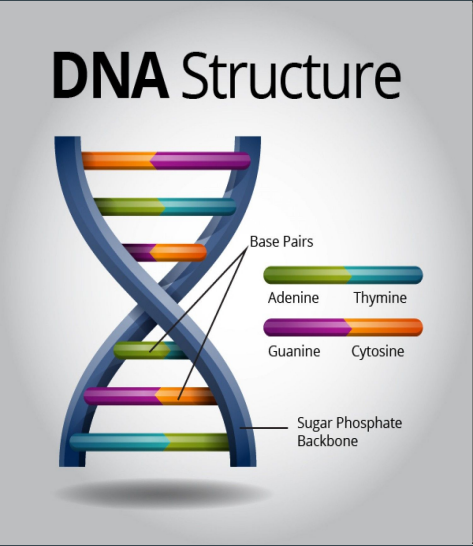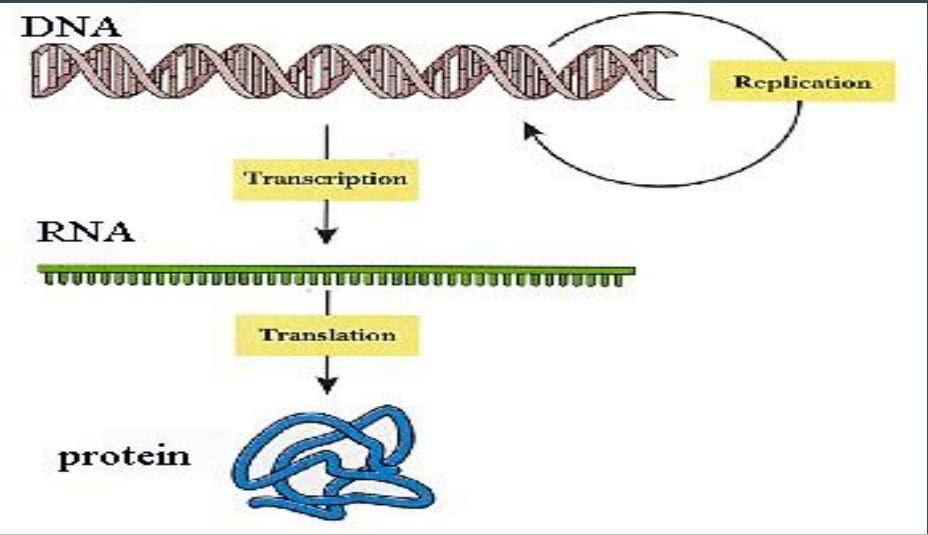Unit 4: DNA
I. Chromosomes and Genes
A. Chromosomes are DNA wrapped around proteins called histones
B. Chromosomes are found in the nucleus.
C. Sections of DNA are called genes.
D. Identical copies of chromosomes are called Chromatids.
E. Centromeres hold sister chromatids together
II. History of DNA
A. Erwin Chargaff (1950)
a. A chemist who developed Chargaff’s Rules
b. He stated that the bases of DNA were paired together in a specific order
i. Adenine (A) pairs of Thymine (T): A=T, T=A
ii. Cytosine (C) pairs with Guanine (G): C=G, G=C
c. If you know the amount of one of the bases, you can figure out all four using Chargaff’s Rules
i. Example: If you know that Adenine is 16% of the sample, then there is 16% Thymine (A=T). Together, Adenine and Thymine make 32% of the total sample.
ii. According to Chargaff’s rules, knowing that 32% of the sample is Adenine and Thymine, we know how much Cytosine and Guanine is there by simply subtracting 100-32 and we are left with 68% of both remaining bases. By dividing (68/2) we figure out that there is 34% Cytosine and 34% Guanine. B. Rosalind Franklin (1951)
B. Rosalind Franklin (1951)
a. A British female scientist who made a huge contribution to the study of DNA by establishing that it existed in a spiral three-dimensional shape with the use of X-ray diffraction.
b. Famous Photo-51: discovered/taken in 1952 most famous x-ray image of DNA that took 100 hours to get the image and calculations to analyze took 1 year
i. Watson and Crick saw this photograph on her desk while attending one of her seminars and built structures of DNA based on this famous photo
c. The shape of DNA is a double helix, think of it like a twisted ladder.
C. James Watson and Francis Crick (1953)
a. They created the first accurate DNA model with the help of Chargaff and Franklin’s research
b. The structure was a double helix (imagine a long, twisted ladder) with the sides consisting of subunits called nucleotides
i. A DNA nucleotide consists of: the sugar- Deoxyribose, a phosphate, and a nitrogen base
c. The sides of the double helix are the alternating sugar and phosphate “backbone”.
d. The center of steps of the the “ladder” are paired nitrogen bases.
i. Adenine always pairs with Thymine
ii. Cytosine always pairs with guanine
iii. This is supported by Chargaff’s Rule
e. Hydrogen Bonds hold the two sides together and is twisted into the Double Helix Shape.
f. Covalent bonds hold the backbone together.
i. Hydrogen Bond are weak bonds.
ii. This is very helpful when DNA replication occurs.
g. They were awarded the Nobel Prize in 1962 for their DNA model.
h. A Nucleotide consists of the following: ● Sugar (Deoxyribose) ● Phosphate ● Nitrogenous Base
D. Frederick Griffith’s Experiment-Transformation
1. Using two varieties of streptococcus, he originally searched for a vaccine. One variety of bacteria had a capsule (like a cell wall) the other did not have a capsule
a. Injection with live encapsulated bacteria– & resulted in the mice contracting pneumonia and dying
b. Injections with live bacteria (with no capsule)- & resulted in the mice living, and their immune system destroyed the bacteria
c. Injection with heat killed encapsulated bacteria- & resulted in the mice remaining healthy.
d. Injection with dead encapsulated bacteria and live non-capsulated bacteria -& resulted in the mice contracting pneumonia and dying
III. DNA Structure
A. DNA (Deoxyribonucleic Acid) is a nucleic acid that is present in all living cells. This molecules contains all of the instructions that determine the traits a living organism needs to survive.
B. DNA is made of repeating subunits called nucleotides. Each nucleotide can have one of 4 bases Adenine Thymine Guanine Cytosine
1. Almost every cell in the human body has 2 meters of DNA.
2. DNA gives each organism its unique characteristics, but it functions in the same manner.
3. A DNA nucleotide consists of the sugar deoxyribose, a phosphate and nitrogenous base (Adenine, Thymine, Guanine, Cytosine)
4. DNA is double stranded.
5. DNA is often coiled around proteins called histones.
a. DNA is coiled into strands, called chromosomes, which are found in the nucleus of Eukaryotes.
b. Genes are segments of nucleotides located on the chromosomes that give specific instructions for a single trait
6. DNA chromosomes in prokaryotes form loose loops within the cell’s cytoplasm.
a. As prokaryotes do not have a nucleus, the DNA loop is in a part of the cell called the nucleoid region.
b. The suffix “oid” means “like” meaning it is like a nucleus because that is where the DNA is found.
IV. RNA Structure RNA (Ribonucleic Acid)
A. It is a mirror copy of a segment of DNA (a gene), which then may be delivered to the ribosome to be converted into a protein.
1. The order of the bases on the RNA strand determines the order of amino acids that will build certain proteins.
2. Proteins are molecules made up of amino acids and are needed to build and repair body structures. They also regulate body processes. They do work within the cell.
3. RNA can also make structures, such as ribosomes and Transfer RNA molecules (tRNA).
B. The sugar in RNA is called ribose.
C. Thymine is replaced by the nucleotide Uracil. (Uracil has a structure that allows it to leave the nucleus; whereas Thymine cannot leave the nucleus because of its structure.)
1. When pairing the bases of RNA, you still follow Chargaff’s Rules.
2. Cytosine still pairs with Guanine; C=G or G=C b. Adenine will now pair with Uracil; A=U
RNA Structure
1. RNA Nucleotide consists of 3 parts: ● Sugar (Ribose) ● Phosphate ● Nitrogenous Base (Uracil, Adenine, Guanine, Cytosine)
2. RNA is only a single-strand
V. DNA Replication and Transcription
A. DNA replication is the process by which DNA makes a copy of itself.
B. Steps to DNA replication:
1. DNA helicase (enzyme) unwinds the DNA. The junction is called a replication fork.
2. DNA polymerase adds the complementary nucleotides and binds the sugars and phosphates. DNA polymerase travels from 3’ to 5’ end. The original DNA is called the template strand.
3. DNA polymerase adds complementary nucleotides on the other side of the ladder while traveling in the opposite direction
4. One side is the leading strand-it follows the helicase as it unwinds
5. The other side is the lagging strand-it’s moving away from the helicase (in the 5’ to 3’ direction).
C. Replication is called semi-conservative, because one half of the original strand is always saved, or “conserved”
D. Problem: it reaches the replication fork, but the helicase is moving in the opposite direction. It stops, and another polymerase binds farther down the chain.
1. This process creates several fragments, called Okazaki Fragments, that are bound together by DNA ligase
E. During replication, there are many points along the DNA that are synthesized at the same time (multiple replication forks)
1. It would take forever to go from one end to the other, it is more efficient to open up several points at one time.
F. Transcription means the process of making a working copy of an original.
1. Transcription is the first step in making a protein.
2. It beings by making a mirror copy of a gene on the DNA strand in the nucleus. This is called messenger RNA (mRNA).
a. It is a duplication of the original “blueprints of the cell”
b. The mRNA is synthesized (made) by an enzyme called RNA polymerase in the same manner that DNA is duplicated
3. Once mRNA is created, it moves through the nuclear membrane to a ribosome to synthesize a specific protein
Transcription
1. One of the strands of DNA is used as a template to create a strand of mRNA
2. Requires the enzyme RNA polymerase
3. Transcription always starts at a region called the promoter.
4. Occurs in the nucleus
VI. Translation
A. Once the mRNA is made, it travels outside of the nucleus to a ribosome (protein factory)
B. The mRNA has to be “translated” by a molecule called transfer RNA (tRNA) (like a translator from English to Spanish or vice versa, the tRNA has to read the code on the mRNA and pair it with the appropriate amino acid it interprets for)
C. The mRNA is fed like a ribbon through the ribosome three bases at a time (three bases are called a codon)
1. The code for one amino acid is three bases on the RNA. The three bases represent a codon.
2. This is where we have diversity in life
a. Diversity is in the differences of sequence of amino acids that combine to make a protein.
b. This pattern comes from the organism’s DNA (million dollar “blue print”.)
D. How the tRNA brings amino acids from inside the cell to make the protein
1. These amino acids come from the foods (protein) that we eat and have been broken down by our digestive system and delivered to the cells through the circulatory and cardiovascular system
2. An amino acid is the basic building block of a protein.
3. The amino acids chemically combine together when the tRNA matches the three base codes on the mRNA
4. If the base code on the mRNA is ACG, the complementary codes on the tRNA need to be UGC to deliver the correct amino acid… in this codon’s case it is cysteine.
5. The growing chain of amino acids becomes the desired protein
a. The codes that are on the tRNA and complement the mRNA are called anticodons
VIII. Mutations
A. A change in the nucleotide-base sequence of a gene. DNA molecule or mRNA code for a protein B. They are caused by mutagens
Codon
1. Each 3 bases on mRNA are called codons.
2. Each codon codes for 1 amino acid.
Translation
1. RNA travels to the ribosome.
2. Ribosomes use the code on the mRNA to build a chain of amino acids.
 Knowt
Knowt
